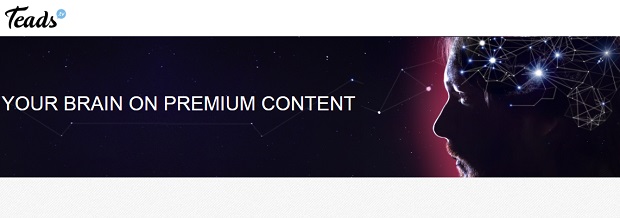Video ads within premium editorial perform better than 8 out of 10 online ads on social news feeds, according to new research.
The neuro-mapping study from video ad marketplace Teads, reveals the powerful, long-lasting effect that video advertising within premium editorial content has on the brain
The study was performed with Neuro-Insight, the world leader in neuroscience-based market research, demonstrating that premium editorial engages viewers with highly memorable content that has a greater impact for video advertisers.
Through testing editorial articles from Teads’ premium publisher partners, including Time Inc., Condé Nast, Forbes and The Atlantic, Teads discovered that premium editorial’s unique value lies in delivering greater effectiveness, and premium editorial content was found to be 16% more personally relevant, or engaging, than social news feeds.
Additional insights from the study include the following:
• Premium editorial delivers a deep experience with a powerful memory impact: For the rational/detailed-oriented (left) side of the brain, premium editorial was found to have a 19% greater impact on memory. For the emotional (right) side of the brain, premium editorial had an 8% greater impact on memory.
• This memorable content helps make ads in premium editorial environments more memorable: Video ads within premium editorial performed better than 8 out of 10 online ads tested when measured by detailed memory encoding, a key metric for ad impact.
• Premium editorial also helps create more memorable peak “hero” moments that influence consumer behaviour: Peak memory describes the highest level of detail memory (correlated with purchase behaviour) achieved. Teads’ video ads had a 15% higher impact on peak detail memory, which has a validated correlation with purchase intent.
• Premium editorial allows for a broader range of ads to be effective: Content and video advertising have separate Neurostates that, when aligned, drive higher effectiveness. Premium editorial achieved a balanced Neurostate, meaning that activity was charted equally on the left and right sides of the brain, thus allowing a broad range of video advertising creative to be effective within premium editorial.
• Social feeds are slightly right brain skewed: Social feeds generate a Neurostate that is slightly skewed to the right side of the brain, which is associated with the global or emotional side. This means that a narrower range (albeit slight) of creative strategies receive a boost in impact from aligned Neurostates.
• The right creative strategy can boost long-term memory: Creative has the power to amplify the strengths seen in both premium editorial and within social feeds. Teads’ study found that ads featuring individuals are star performers on premium editorial, whereas ads showing complexity and movement perform well on social. Lastly, overt branding, often thought to be a way of delivering a strong branding effect, may have the opposite impact on memory encoding.
Jen Wong, Chief Operating Officer and President of Digital, Time Inc., said: “As our partners look for ways to allocate their budgets, this study reinforces the effectiveness and engagement of video advertising within premium editorial content. Advertising within high-quality content is a win-win for our partners who want the highest ROI.”
“This study validates something Teads has felt strongly about for some time—that advertising within premium editorial is the most effective option for advertisers, hitting on a number of key performance metrics,” said Rebecca Mahony, CMO, Teads. “Neuro studies are really pushing the envelope of what is possible when it comes to measuring how ads resonate with consumers and offer a unique opportunity to really drill down on the elements and context considerations surrounding advertising. We’re excited to see that results support the concept that premium editorial helps video ads rise to the top.”
Teads and Neuro-Insight recruited 100 respondents, split in two cells groups, for the study, each of whom were outfitted with neuro-mapping caps used to measure brain response. Both groups were exposed to eight identical mobile video creatives on either their Facebook newsfeeds or outstream video ads from Teads that appeared across several of Teads’ premium publisher customers.
The key performance indicators measured for content and ad evaluation were engagement and memory encoding. Engagement measures activity in the brain related to the level of personal relevance a person feels toward a content experience. It is the key metric for content performance and content environments with high engagement, creating higher impact for video advertisers. Long-term memory encoding is measured within each brain hemisphere and offers insight into the impact content has on the subconscious mind. This metric is a validated and proven ad-effectiveness metric. Brand experiences with high memory encoding can affect consumer choice and create market value.
To download a copy of Teads’ study, please click here: http://info.teads.tv/your-brain-on-premium-content

